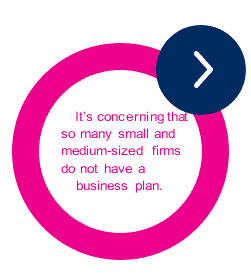If you want your business to achieve high ambitious turnover growth of at least 20% year on year, you need a business scaling strategy that incorporates a strong vision and a solid business plan.
Helping your small business to grow, to achieve a sustained growth, will involve careful planning and most likely involve taking calculated risks.
You need to think about what you want to achieve. Where do you want to be 1 year from now? You won’t find that easy unless you know your target market and your customers thoroughly, have products and services they’re keen to buy and be aware of the expenses you’re likely to face.
Managing Growth
To manage your company’s growth, it’s critical that you refer often to your business plan and keep an eye on the business’ key metrics, benchmarks and timelines.
You need to make sure that people have actionable activities; things that they can do and which can be measured.
As well as having repeatable processes and measuring your progress on a day-to-day basis, it’s crucial to be able and willing to adapt and be flexible if things change.
Knowing all your Numbers
Besides monitoring KPIs for turnover, gross profit percentage and salaries, it’s also important to establish KPIs for your profit per product and customer profitability.
You need to know whether you’re doing more business with each of your customers than you were doing the previous year, for example. That’s more important than focusing on going out and winning new customers.
Equally important is being aware of your balance sheet.
Other important KPIs are those that relate to your customer conversion rates, your sales profitability, and your working capital
Funding Growth
You also need to have a clear understanding of what’s achievable both in the short and long-term.
At some point, you’re likely to need to invest in the company to achieve the revenue growth and scale your business the way you want.
That might be to cover the cost of hiring of more team members, the training of your existing employees and their retention, or the development of new product lines or services to boost sales.
Like some companies, you might need additional funding to be able to hire in external experts such as the CFO Centre’s part-time CFOs to fill the personnel gaps within the company as it scales up.
You will also have to decide how you will fund the additional resources you need to sustain your growth.
Companies that enjoy strong growth are prepared to employ the right people and to raise the money they need. Sometimes they have even personally guaranteed the loans they’ve taken out on the company’s behalf.
They’re taking well planned, well considered risks.
The more risk-averse often shy away from offering personal guarantees on loans or embarking on mergers and acquisitions that would help to fuel their rapid growth.
Invariably however you do need to borrow money to achieve growth.
Merger/Acquisition Growth
One of the fastest ways to scale your business is to merge with or acquire another business in your market. Or, in the case of retail or hotel/restaurant companies, open new branches in different locations. It could also involve forming a joint venture partnership.
You need to ensure there are alignment and support for the from all the company’s stakeholders. Including customers, senior management, non-executive directors, potential joint venture or merger partners. And your banks and other finance institutions, your accountants, and your immediate team.
The benefits of choosing the right target company for your merger or acquisition can mean your market share and assets increase.
Your new staff may have more expertise and skills than your existing employees.
The merger or acquisition may make it easier to obtain capital if or when you need it.
But this kind of inorganic growth can be problematic. The purchase price for the acquisition can be prohibitive while restructuring charges can increase expenses. It takes time to benefit from the knowledge or technology your company has acquired through the merger or acquisition.
You may find you need to recruit more managers to cope with the increased workforce.
The business may move in a direction you never anticipated. Or the new company may grow too quickly which puts it at greater risk.
Often, the combination of organic and inorganic growth gives you the best outcome. Your company can diversify its revenue base without having to rely purely on current operations to grow your market share.
Three tips to scale your business
- Be open minded about taking on investment. Scaling your business will be hard work and you need to find a way to do it without running out of cash.
- Conduct market research to ensure people want to buy what you’re offering. It’s got to interest and excite them so much they’re willing to hand over cash for it.
- Reward your employees and make sure they understand and are engaged with your vision for the business. You’ve got to bring them on the journey.
Contact us now if you want to learn how a part-time CFO (Chief Financial Officer) can help you to implement the best business growth strategy.






